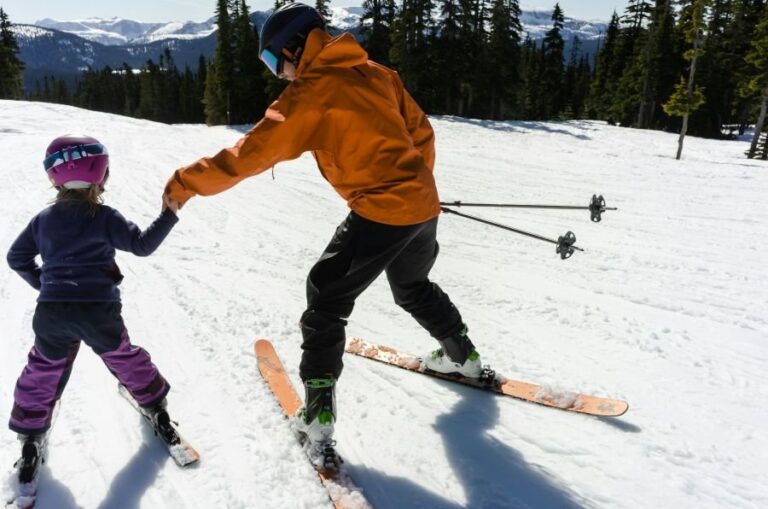Ski goggles are an essential piece of kit for children hitting the slopes. They protect young eyes from harmful UV rays, which can be particularly intense when reflected off snow surfaces.
The winter sun can be deceptively strong, even on cloudy days. Quality goggles with at least 95% UV protection are vital to safeguard your child’s developing vision while they enjoy their skiing adventures.
Goggles also provide crucial protection from wind, snow, and ice particles that can irritate or potentially damage eyes. When your little ones are zooming down the slopes, the last thing you want is for them to squint against blowing snow or brightness.
Choose goggles specifically designed for winter sports that fit properly around your child’s face. A good fit ensures no gaps where cold air or snow might enter.
For warmer, sunnier days, wrap-around sunglasses with UV protection can be an alternative. However, goggles typically offer more comprehensive protection, especially in colder or snowier conditions.
Remember that children are more susceptible to eye damage than adults, as their eyes are still developing. Protecting their vision should be a top priority during any ski trip.
6. Choose a child friendly resort
When planning your family ski holiday, selecting a resort with the right amenities for children can make all the difference. Look for resorts that offer dedicated children’s areas with magic carpets and gentle slopes designed specifically for beginners.
Many family-friendly resorts provide specialised childcare programmes and ski schools with small class sizes. This ensures your little ones receive personalised attention, helping them progress more quickly and confidently on the slopes.
Consider accommodation options located close to the slopes to minimise the trek with tired children and heavy equipment. Ski-in/ski-out lodging is ideal for families, saving you the hassle of lengthy walks or shuttle rides with children in tow.
Check if the resort offers additional activities beyond skiing. Indoor pools, tubing parks, or ice skating rinks provide fantastic alternatives when your children need a break from skiing or if weather conditions aren’t favourable.
Some resorts offer useful perks like ‘Kids Rent Free’ packages or discounted family tickets. Keystone Resort, for example, is known for its family-friendly atmosphere and special offers for children, making it easier on your wallet.
7. Take regular breaks to keep spirits high
Skiing with kids requires a thoughtful approach to pacing. Regular breaks throughout the day can make all the difference between a memorable family adventure and a meltdown on the mountainside.
Children tire more quickly than adults, especially in the cold and at high altitudes. Plan 15-20 minute breaks every hour or so, allowing everyone to rest their legs and warm up properly.
The promise of hot chocolate can be a powerful motivator when energy levels start to dip. Use these treats as rewards for completing runs or mastering new skills on the slopes.
Pack small, easily accessible snacks in your jacket pockets. A few gummy bears or small chocolates can boost spirits instantly when fatigue sets in.
Breaks also provide perfect opportunities to hydrate and refuel with proper meals. Skiing burns significant energy, and hungry children rarely have fun.
Choose comfortable, warm spots for your breaks. Many ski resorts offer family-friendly rest areas where you can relax without feeling rushed.
Remember that the goal is enjoyable family time, not maximising slope hours. Quality skiing experiences with happy children will create far better memories than pushing through exhaustion.
Packing Essentials for Kids
Preparing for a ski trip with children requires careful planning to ensure they stay warm, comfortable, and safe on the slopes. The right gear makes all the difference between a day of fun and a day of complaints.
Must-Have Clothing
When packing clothing for kids’ ski adventures, the key is layering. Start with thermal base layers that wick moisture away from the skin. These should be made of synthetic materials or merino wool—never cotton, which stays damp when wet.
For the middle layer, pack fleece jumpers or insulated tops that provide warmth without bulk. These can be removed easily if temperatures rise during the day.
Waterproof, breathable ski jackets and trousers are non-negotiable. Look for items with snow gaiters to prevent snow from getting inside boots.
Daily Clothing Checklist:
-
2-3 sets of thermal base layers
-
2 fleece jumpers
-
Waterproof ski jacket and trousers
-
3-4 pairs of ski socks (wool blends are best)
-
Neck gaiter or balaclava
-
2 pairs of waterproof gloves or mittens (mittens are warmer for little hands)
-
Warm hat that fits under helmet
Safety Gear Checklist
Proper safety equipment is absolutely essential for children on the slopes. A well-fitting helmet is the most important item—never compromise on this. It should sit snugly without rocking back and forth or side to side.
Quality ski goggles protect young eyes from harsh glare, wind, and snow. Look for ones with UV protection and ensure they create a proper seal with the helmet.
Safety Equipment List:
-
Helmet: Must meet current safety standards and fit properly
-
Goggles: Should be compatible with helmet and offer UV protection
-
Sun cream: Minimum SPF 50, applied regularly
-
Lip balm: With sun protection
-
Refillable water bottle: To stay hydrated throughout the day
-
Small backpack: For carrying snacks, water, and extra layers
Consider a high-visibility vest or bright clothing to help you spot your child easily on busy slopes. Some parents also find walkie-talkies helpful for older children who might ski slightly ahead.



